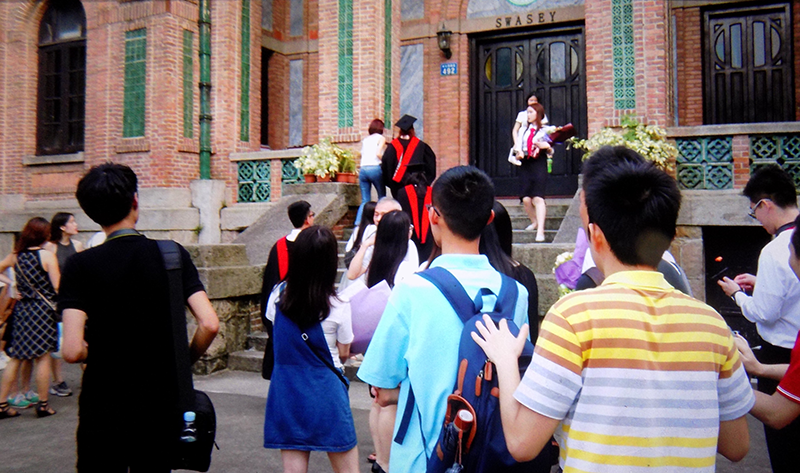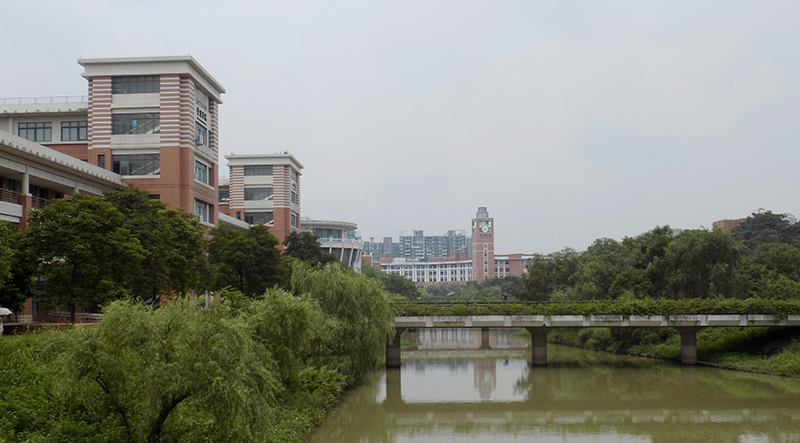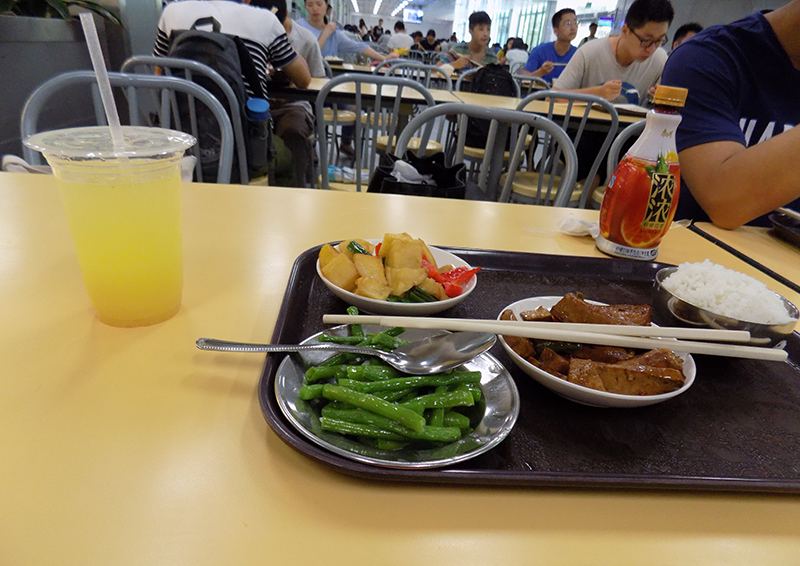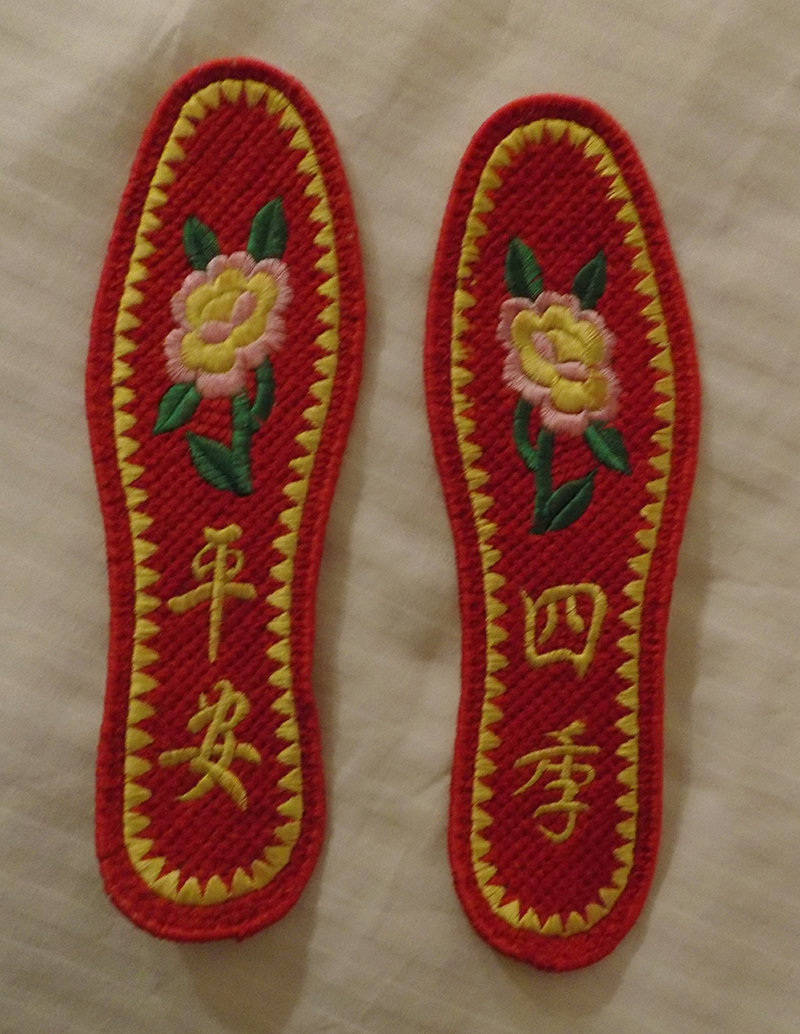Graduation week has special meaning to me as a university professor: It signals the end of my time with my students and the beginning of their new professional careers. As we end the academic year, I am remembering graduation week last summer. I spent part of my sabbatical from my university in Philadelphia at Sun Yat-sen University in the Guangdong province of southern China. The Sun Yat-sen University campus looks a lot like my own university campus during graduation time, with students clad in black graduation gowns milling around campus, many carrying bouquets of flowers and followed by misty-eyed parents and grandparents who keep stopping to snap pictures and take videos of their darling offspring. (And who can blame them for being so proud? I wept openly with pride throughout both of my children’s preschool graduations, and all they had to do to graduate was show up to class and not bite the other children.)
I had gone to China while on sabbatical at the invitation of a Chinese colleague. Prof. Zhang invited me to her school to collaborate on some research projects and to teach a two-week short course on library and other information services for youth to a mixed class of undergraduate and master’s students in the School of Information Management. I asked if I would have a translator for the lectures, but Prof. Zhang assured me the students all spoke English, English being a required subject for all Chinese students throughout middle school and high school.

I normally don’t use PowerPoint slides for class because I think they thwart student participation, and participatory learning is a main goal of my teaching. However, I knew from working with Chinese graduate students in the U.S. that Chinese students are accustomed to more formal lecturing, so before I left for China I spent many hours creating a series of detailed PowerPoint slides. I was told that there would be a total of six class sessions, each four hours long. I planned to spend half of the sessions lecturing on theories of child and adolescent development, and half on research into how children and teens interact with information technologies. These are topics I have taught for many years; it would be a snap to teach the course.
My class was held on East Campus, several miles from South Campus where my hotel was located. East Campus is much more modern than South Campus, with gleaming stone and glass buildings and lush, sub-tropical flowering plants all over the campus grounds.

I walked into class the first day anxious to see my students. Judging from the looks of them, I guessed that about six were undergrads and about eight were master’s students. I stood at the front of the room and introduced myself. I asked the students to go around the room to introduce themselves to me, but they stared back at me mutely. I tried asking a couple of them their names, but they didn’t respond.
I started to get nervous. My teaching style leans heavily on conversations with students. If no one else was going to talk, it was going to be a long, painful four hours. And it was hot in the room. Really, really hot.
I had planned to pepper my lectures with short Youtube videos to break up the monotony — a video on the developmental value of play, one on the importance of dialogic reading, and so on. I walked over to the computer at the front of the class and clicked on the link to the first video. A warning message in Chinese appeared on the screen. I had forgotten that the Chinese government blocks Youtube. None of the videos I had selected were usable.
No student participation. No videos. I began to panic, making me feel even hotter.
I moved on to the first PowerPoint slide and explained that we would be studying child development over the next several class sessions, starting with babies and moving up to adolescents. I looked for signs of comprehension or interest in the students’ faces. Nothing. I noticed an undergrad in the front row pull out her phone and begin surfing Weibo, a popular Chinese social network. An undergrad near the back of the room slumped over the table in front of her and promptly fell asleep. Most of the other students were a bit more polite, but as I spoke they mostly just looked confused. A few gave up trying to understand me and began to type on their laptops, obviously doing homework for other classes.

Between my growing panic and the stifling heat of subtropical China in the summer, I began to sweat. I could feel drops of sweat welling up on my neck and rolling down my torso. It was not a pleasant feeling.
I kept lecturing, stopping every 15 minutes or so to ask the students questions. No one other than the two graduate students assigned to act as my hosts responded — not so much as one word from the other students. In the U.S., when I’m in the classroom my students often talk so much that I have to stand in the front of the room and yell: “Hey, everybody! Quiet down and listen to me for a minute!” to make myself heard. I longed to be back in one of those noisy, rowdy classrooms.
Prof. Zhang had told me it would be fine to end class early. Half an hour in I began to wonder how early was “early.” During a bathroom break one of my grad student hosts told me that they usually stopped class after two hours and went to lunch. I jumped at the chance to shorten the four-hour class by half, and as soon as my watch indicated that two hours had passed, I sent all the students off to lunch.
After eating in the school cafeteria, I bumped into one of the students from class in the hallway near my campus office. “Did you learn anything from class this morning?” I asked her hopefully.

Her brow wrinkled as she struggled to think of something to say. “I think you are a very humorous professor,” she finally said, and she scurried away before I could ask her anything else.
Two hours of class, and she had learned nothing. Not one single thing. It was a disaster.
I asked my grad student hosts for advice. They said that the students probably had trouble understanding me because I spoke too quickly, and that Chinese students would be nervous about speaking English in front of me. And since the students weren’t planning on working with youth for their careers, they probably weren’t too interested in the topic.
Ouch.
The next day I tried again with my prepared lecture, trying to speak more slowly. The sleeping undergrad continued to sleep. The Weibo-ing undergrad continued to surf. The other students all looked bored or confused.
It was another long, hot, miserable two hours. There were only two points at which anyone showed any interest. When I made an off-topic comment about digital copyright issues in the U.S., one of the master’s students asked a few related questions. And when I asked what kinds of movies, books, or music were popular with Chinese children, another one of the master’s students perked up. “Kung Fu Panda!” she replied with a big grin.
I realized that teaching college in China requires a fundamentally different approach than teaching college in the U.S. The content, the theoretical/practical balance, the speed of delivery, and the student engagement methods I had planned were all wrong.
I returned to my hotel room after class and spent the afternoon, the evening, and much of the night ripping apart and redoing all of the materials that I had prepared for the course. I eliminated two-thirds of the remaining content and focused on teaching just the introductory-level material. I decided to focus only half of the remaining course on youth-related issues (even though I was being paid to focus on that very topic) and the other half on issues more likely to be of interest to the students. I began drafting a set of mini-lectures, brief overviews of current issues in digital information management, information privacy, information security, digital preservation, and much more.

I designed the next day’s class to switch topics every half hour to keep the students interested and to enable coverage of multiple topics during the two-hour session, maximizing the chances that at least one topic would interest each student. I also changed my methods for encouraging student participation, weaving small-group discussion questions and ungraded collaborative quizzes into the classes every half hour or so to enable student-led small-group discussions in Mandarin or Cantonese (the two most commonly spoken languages in the Guangdong Province — sadly, I speak neither).
Understanding that popular culture was a hook for some of the students, I began the lecture the next day on adolescents’ use of mobile technologies with a series of screen shots of eight social networks/platforms/apps that were popular with U.S. teens at the time: Snapchat, Kkik, Tumblr, Vine, and more. I discussed the features of each one and explained how they differ. One of the master’s students asked if I was familiar with Zach King’s Vines, and we spent a several minutes watching some of his best Vines, which I projected onto the screen in the front of the classroom.
Most of the students seemed interested. The Weibo student even shut down her phone to pay attention. As soon as I moved on from describing the sites — several of which are blocked by the Chinese government, so the students were especially curious about those — the Weibo student turned her phone back on and went back to online chatting with friends, but most of the other students remained interested (albeit quiet) until we stopped for a bathroom break.
Although I had adjusted the content and engagement activities, I still had a delivery problem: Try as I might, I just couldn’t remember to speak slowly in class. After some in-class experimentation, I finally hit upon a physical solution. I needed to drink water throughout class to keep from overheating in the muggy subtropical heat. I started keeping my bottle of water on the lectern at the far right of the front of the classroom, but I spoke from the center front. Each time I needed to change a slide, I would walk half-way across the room to the lectern, hit the button for the next slide, take a gulp of water, and the walk back to the middle of the room. The walking, slide changing, and drinking forced me to stop talking for a couple of minutes between slides and gave the students extra time to process information that they were hearing in a foreign language.
I had moderate success with the remaining classes. Three of the master’s students started to contribute in class, making comments and asking questions, serving as translators for some of the other students whose English skills were less developed.
By the final class, most of the students looked interested for at least part of the lecture. I wouldn’t call that final class “good,” but it was definitely better than my first disastrous, sweaty attempt two weeks earlier.
After I ended the final lecture, I wished everyone goodbye and farewell. The students clapped politely. I began to pack up my backpack to head out the door. One of the more talkative master’s students rushed up to me, blushed, and handed me a plastic bag. Inside were two lovely hand-embroidered shoe inserts. She said that her sister-in-law had sewn them, and that she would like to offer them to me as a present. They are beautiful — delicate, evenly stitched pink flowers against a red and yellow background. They are far too beautiful to step on; I framed them as art instead of putting them in my shoes. I was deeply touched by her gesture and by her gift. Perhaps she gives all of her professors beautiful handmade gifts; I don’t know. But I choose to believe that some of my lessons somehow reached her — that I somehow made at least a tiny positive contribution to her life.
And that is all that I can hope for from my teaching, whether I’m on familiar ground teaching back in the U.S., or learning how to teach all over again as far away as Southern China, 8,000 miles from home. •
Feature image created by Shannon Sands. All other images taken by the author.





